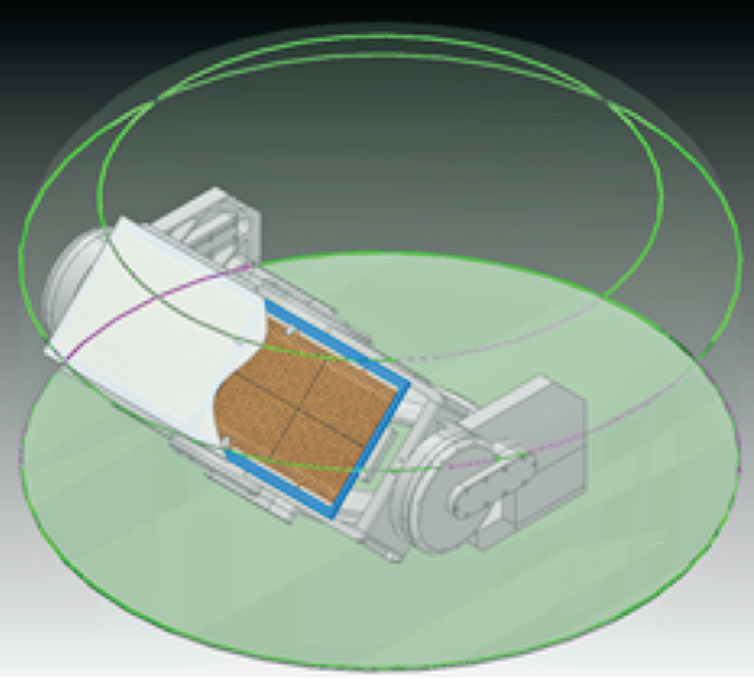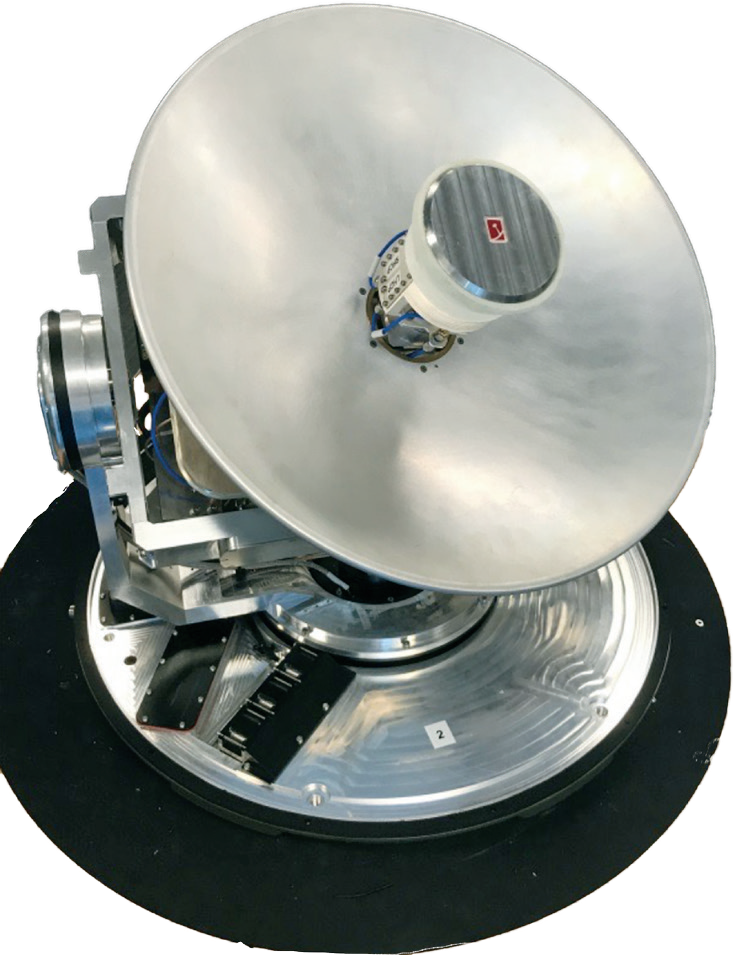In today’s Ka-band satellite communications-on-the-move (COTM) industry, one of the most significant evolutions for ground terminal design is to employ compact, low-profile, and reconfigurable flat-panel antennas (FPAs) as a replacement for their conventional counterpart, the dish antenna, dominated by its bulky parabolic reflector.

Figure 1. A flat panel array with mechanical pointing in both azimuth and elevation angles. Such an array can maintain constant gain when pointing in any direction, but generates a fan-shaped beam.
Such evolution is naturally driven by new market demand and user expectations for high-speed satellite communications from ubiquitous on-the-move platforms, such as vehicles, unmanned aircraft systems, and aeronautical services.
The satellite terminals installed on these on-the-move platforms would ideally be both conformal in geometry and low-profile (i.e., to become invisible) to better fit the aerodynamic surface in a limited footprint; and lower weight, to meet the payload quota the vehicle can support. Obviously, volume-based antenna solutions using parabolic or offset reflector dishes are not ideal fits for such requirements.
New opportunities in the COTM market have triggered numerous initiatives to find versatile and low cost flat-panel solutions in Ka-band that can approach the RF performance of their parabolic counterparts. In general, such FPAs are required to deliver a high antenna gain (typically up to 30 dBi) and to support a beam-steerable function that maintains a reliable communication link with satellite over any terrain.
Over the past three years, the design of Ka-band SATCOM FPAs has become one of the most attractive and best supported R&D topics in the industry and the research community alike. Although the concept of generating a focused-beam through a planar-shaped antenna is not new, it is still extremely challenging to design a feasible FPA solution that meets the RF constraints, matches the market needs, and is commercially profitable.
Over the past several years, a number of revolutionary antenna concepts and prototypes have been showcased by worldwide innovators (such as C-COM, Kymeta, and Phasor), but questions remain unanswered about what compromises have been made to meet all the essential antenna patterns and RF parameters for reasonable performances at Ka-band, while maintaining a reasonable cost. This makes it difficult to anticipate when and how FPA technology will dominate the COTM market as a replacement for traditional dish antennas.
Future solutions for flat panel antennas roughly follow four parallel routes as grouped below, in terms of their design philosophy and working principle.
1) FPA with fixed radiation pattern, rotated mechanically in azimuth and elevation.
The solutions in this group are simple and straightforward; the FPA itself doesn’t provide the beam steering function, but requires an external mechanical subsystem to rotate the antenna body and change the beam direction. A typical product in this group is the one made by DRS or Israeli company Elbit. “Chopped” parabolic dishes are similar to antennas in this category.
As the FPA generates a static radiation pattern, the antenna can easily be designed with a stable and high-gain radiation pattern over a wide frequency range, although it must be noted that low profile antennas that are elongated in shape (to achieve a higher gain) will have a fan-shaped beam that fails many certification requirements. This group of antennas could, in the future, be coupled with a sophisticated monopulse tracking system to enrich their motion performance, as do those already offered by EM Solutions.
In this group of antennas, future solutions can mainly be used to reduce the terminal’s body weight on large-footprint platforms, but generally such solutions will not lead to ubiquitous low-profile or conformal terminals because of their requirement for azimuth and elevation movement and the need to maintain good radiation patterns.
2) FPA using a phased antenna array
In this group, FPAs are designed as two-dimensional antenna arrays excited by a feeding network of signals that are varied in phase. Best known in radar applications, a phased array antenna can generate a focused beam useful for satellite communications, but in low volumes such systems can be very expensive.

Figure 2. A flat panel array with electrical steering in both azimuth and elevation angles. Although low profile, this antenna loses gain and pattern integrity as it points off-axis
Recently, Phasor and C-COM have developed a promising low-cost phased array solution in Ku-band, but it is unclear if the same design methodology is applicable in Ka-band.
3) FPA using a digitized impedance surface
In this group of antenna arrays, the FPA is made from a tunable holographic impedance surface consisting of a large matrix of metamaterial units digitally controlled. The best known product in this group is the one made by Kymeta.
The solutions in this category should reduce the FPA manufacturing cost compared with phased array antennas, but are faced with challenging compromises between antenna radiation performance, resolution and accuracy of steering, and sidelobe levels, as well as limited bandwidth due to the inherent narrowband properties of metamaterials.
4) FPA made using sliding mechanical structures for two-dimensional steering
In this group, the FPA is designed as a surface-wave generator by using the same theoretical framework once widely employed in optical science. The sliding mechanical structure within the FPA is used to steer the beam along the elevation angle, while a separate mechanical subsystem is required to rotate the entire antenna body horizontally to change the beam direction in the azimuthal plane.
A product type using similar concepts is that made by ThinKom. Such a design approach has the potential to reduce the manufacturing cost of the FPA, while maintaining a high-quality radiation pattern. However, the FPA will suffer degradation in its radiation efficiency as it is steered, with fluctuating antenna gain in different beam directions, and limited working bandwidth.

Figure 3. An EM Solutions X-band Taipan terminal. This antenna has optimum performance in all respects if the height profile can be accommodated.
All the solution types listed above are worthwhile for further investigation and development, as they all have the opportunity to evolve towards a versatile and profitable product, depending on the application. In such developments, it is important to keep in mind the performance advantages of the mechanically steered parabolic antenna solution — constant high antenna gain and controllable antenna patterns.
These advantages will inevitably be compromised by reducing the profile and volume in moving to a low profile solution, with the choice of FPA vs parabolic antenna dictated by the relative importance the user will ultimately place on the value of low profile, compared with antenna gain off-axis (which can be critical to be able to communicate with the satellite at all).
With its Cobra and Taipan OTM terminal portfolios that use steered parabolic antennas, EM Solutions has traditionally valued high antenna gain rather than low profile, and sweetened the choice by offering monopulse tracking for very robust performance over rough terrain, as well as coverage of multiple operating bands for assured communications, two advantages not yet achievable with an FPA approach.
How can these two advantages be retained in the FPA approach? At EM Solutions, a long-term research collaboration has been established with the University of Queensland (UQ) to develop a versatile and low cost FPA solution for the COTM market.
Based on the most recent electromagnetics research from UQ, the RF and antenna designers from both organizations have identified a strategic roadmap to develop a low cost Ka-band FPA solution with satellite tracking capabilities.
The proposed product can integrate with the company’s current SATCOM systems and offer many of the advantages available in its existing OTM terminal suite. First demonstrations of the prototype antenna will be shown to lead customers in early 2018.
Ultimately, there is no “best” answer for antenna choice. To use a racing analogy, it is “horses for courses”! Parabolic antennas offer the advantages of constant high gain, and certified compliant antenna patterns over broad bandwidths. Flat panel antennas compromise two or all three of these advantages in favor of low profile.
The optimum choice depends on the application, link budget, and the value placed on size, weight, and power. The search for the holy grail continues!
www.emsolutions.com.au
Dr. Yifan Wang is an Advance Queensland Research Fellow with joint appointments at the University of Queensland and EM Solutions Pty Ltd. in Brisbane, Australia.
His research interests are in the areas of complex electromagnetics modeling and system-level development of RF/Microwave equipment for remote sensing and communication applications.
Since 2014, he has been working with the Antenna Technology Development Group at EM Solutions to develop a millimeter-wave reconfigurable flat-panel antenna that complements EM Solutions' existing Cobra and Taipan multi-band terminals.


